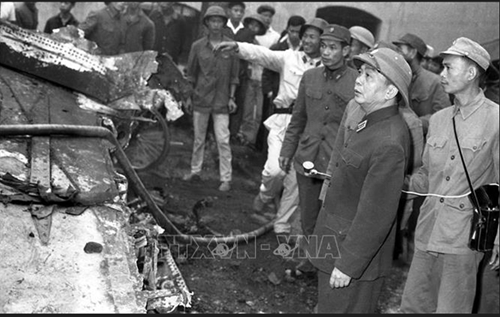The victory forced the U.S. government to sign the Paris Peace Accords, ending the war, restoring peace in Vietnam. Furthermore, it affirmed strategy of General Vo Nguyen Giap, the Commander-in-Chief and the big brother of the Vietnam People’s Army (VPA), in directing the construction of the entire people’s air defense posture - a new development in Vietnam’s unique people’s warfare.
Making preparation for fighting against B-52 stratofortress
From the beginning of 1965, in addition to mobilizing troops to the southern theater of Vietnam, the U.S. also deployed B-52 bombers from an air force base in the Pacific with the aim of destroying the North of Vietnam. At the same time, the foreign invaders also disseminated information about the power of B-52s to threaten the Vietnamese people.
    |
 |
|
General Vo Nguyen Giap inspects the aircraft downed by Hanoi troops and people in Ngoc Ha village, Hanoi in late December 1972. |
Previously, President Ho Chi Minh had forecast, “Sooner or later, the U.S. will mobilize B-52s to destroy Hanoi... In Vietnam, the U.S. will definitely lose, but only when they lose in the air of Hanoi.” As Secretary of the CMC and Defense Minister, General Vo Nguyen Giap directed the VPA’s General Staff and the Air Defense - Air Force Service (ADAF) to seek measures to counter the B-52.
In May 1966, the General ordered the VPA’s General Staff to send Missile Regiment 238, Division 363 of the ADAF to Vinh Linh district in Quang Tri province. The regiment was tasked with working with radars, electronic reconnaissance systems, and air force troops to study the features and operations of the B-52.
At a meeting in September 1971, the Politburo and CMC agreed that in 1972, the enemy would withdraw its troops if they reached their target, otherwise, they would conduct air strikes in North Vietnam, so we should be ready in any circumstances.
After the meeting, General Vo Nguyen Giap noted that B-52s might attack Hanoi in addition to the South. The ADAF was requested to study the Stratofortress. Meanwhile, radar, missile, and air force troops also took part in the training programs as scheduled. Furthermore, several mobile sites were secretly built, and Hanoian militiamen and some cities were equipped with anti-aircraft firepower.
In June 1972, under the direction of General Vo Nguyen Giap, a conference was held to discuss measures to fight against the B-52. Delegates at the event pointed out the shortcomings of the aircraft and mapped out solutions to destroy them. A document titled “How to Defeat a B-52” was finalized in October 1972, becoming a manual for air defense troops.
During the period, the Department of Intelligence, the ADAF, and functional organs were tasked with exploiting information related to the B-52, and studying and developing weapons and equipment to counter the bombers.
The General also requested the troops to forecast the main attack directions of the enemy. During the 12 day and night campaign in Hanoi, almost all of the enemy aircraft took advantage of the terrain to fly Northwest as forecast. Therefore, the VPA’s General Staff and ADAF sent troops to these scenes to successfully destroy B-52s in the Northwest, Southwest, and South of Hanoi, where the air force used MiG-21 fighters. At the same time, the people’s air defense and radar systems were widely deployed to restrict B-52s. This was a unique and innovative feature in the fight against B-52s in the Air Defense Campaign 1972.
On October 20, 1972, General Vo Nguyen Giap worked with the ADAF to map out operational orientations of the air defense campaign against B-52s to protect Hanoi. He noted that we should be ready and make thorough preparations to defeat the enemy’s plot to invade the North.
On November 25, 1972, in the directive “Strengthening Combat Readiness,” on behalf of the CMC, General Vo Nguyen Giap underscored, “In the near future, the enemy can severely bombard targets outside the latitude 20. They can use B-52s to attack key points in Hanoi and Hai Phong...”
Defeating U.S. stratofortress
After winning the election in November 1972, President R. Nixon sought to delay the signing of the Paris Peace Accords and drew the Linebacker II plan, and launched strategic air raids with B-52s against Hanoi and Hai Phong. On December 14, 1972, the plan was approved by the then U.S. President. On December 18, 1972, the U.S. started its largest-scale strategic air operation since the Second World War in the North of Vietnam.
However, they were surprised by our people’s air defense system. During the first night of December 18, three U.S. B-52s were shot down. On December 26, eight others were destroyed. After the 12 day and night campaign, 81 aircraft of all kinds were downed in the North, including 34 B-52s.
Throughout the campaign, General Vo Nguyen Giap was present at the headquarters to direct functional units. He also visited missile units in Chem, Yen Nghia and the headquarters of the ADAF in Tram Mountain (Chuong My district, Hanoi). He also accompanied President Ton Duc Thang to inquire after people in Kham Thien street after the U.S. Air Force used a B-52 to bomb the street. His presence actually inspired troops and people to defeat the enemy.
“The 12 day and night campaign against B-52s in late 1972 was an outstanding feat-of-arms. For the first time, we successfully organized and carried out a large-scale anti-aircraft campaign to defeat the U.S. strategic air raid, causing the heaviest losses to the U.S. Air Force in its history,” underscored General Vo Nguyen Giap.
After 70 years of service, the B-52 has fought in many parts of the world and remained a strategic weapon of the U.S. Air Force... But it was only shot down by the VPA. It was the victory of the entire Party, military and people, including the special contribution of General Vo Nguyen Giap, marking a new development in the art of the people’s warfare in Vietnam.
Translated by Minh Anh